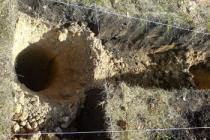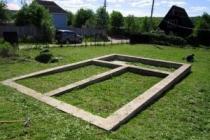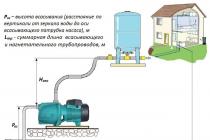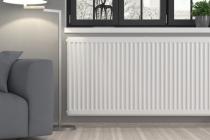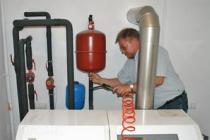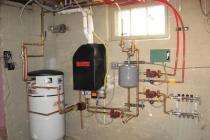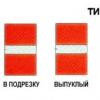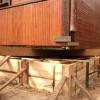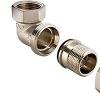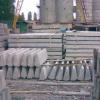If you decide to equip a heating system for a cottage or a country house, then you need to think about efficiency, maximum reliability and ease of work.
Features of arrangement
If we are talking about forced circulation of the coolant in the pipeline system, then in the process of carrying out the work, it will be necessary to install a pump, which should be located on the section of the heating main. Thanks to this interaction, it will be possible to ensure faster and more constant movement of water. The disadvantage in this case is the cost of installing additional equipment. If you are interested in the scheme of a private house, then there will be no need to install a pump. This is due to the fact that the density of hot water is much lower than that of cold water. Due to this, one liquid is pushed out by another. The coolant, moving along the highway, gives off a certain part of the heat to the batteries, gradually cooling down. Returning back, the cold liquid displaces the hot and light into the pipes. This cycle repeats itself constantly. The process cannot be suspended in any way until the boiler is warming up. If necessary, the heating scheme with natural circulation (this concerns a private house in the first place) can be supplemented at any time with a pump, which the owners can use if necessary for quick and uniform heating of the dwelling.
Main positive characteristics
The presence of a pump entails additional energy costs. Whereas its absence, on the contrary, allows for good savings. Such systems are completely silent and do not cause unnecessary vibrations. The Leningradka system (with natural circulation) has a lot of advantages, among them a unique ability to self-regulate, a very long period of trouble-free operation, which is 30 years, thermal stability and high maintainability.
Preparation for work
If you decide to produce it yourself, then you should consider the heating scheme (with natural circulation) of a private house. The outline will contain a specific set of elements. Among other things, it contains: an expansion tank located at the highest point; pipeline, which can be single or double; heating radiators, as well as boiler equipment. The latter will heat the coolant. Before starting work, it is important to remember that the speed and strength with which water will move through the heating system depends on the volume, weight, and density of the hot liquid. An equally important role is played by the inner diameter of the pipes, the resistance coefficient depends on this parameter, as well as the height of the installation of heating radiators in relation to the boiler. The foreman must know that special requirements are imposed on horizontally oriented pipelines. They must be installed with a mandatory slope of 5 millimeters per meter, turning the pipes in the direction of travel. Only in this way the cooled water will tend to the boiler. The heating scheme (with natural circulation) of a private house involves the installation of fewer elements in the path of the coolant, which would be able to increase the resistance.

Power calculation before installation
If you have chosen a heating scheme for a private house with natural circulation, then before you start arranging the system, you need to determine the capacity of the boiler equipment. You can carry out such calculations in any of the following ways. The first involves the use of volume, the second - the area. The practitioner should remember that each of these options will only provide approximate results under the most ideal conditions. If the building is not insulated, you should purchase equipment with a small margin. Whereas for energy-saving buildings it will be enough to take a figure within 60 watts as a power per square meter value.
Determination of capacity by volume
If you are implementing a private house with natural circulation, then the most accurate calculation will be the volume of the heated room. Initially, this value must be determined by multiplying it by 40 watts. The next step is to add correction factors. If we are talking about a private house, and the room borders on the street above and below, then you need to multiply the result by 1, 5. If there is a room that is located near an insulated wall, the value should be multiplied by 1.1. In the presence of an insulated wall, multiplication is performed by 1.3. As for each door that faces the street, then for them you need to add 200 watts. For the window, it is necessary to add 100 W, the indicator equal to 70 acts as the minimum value, the coefficient in each case will depend on the dimensions of the opening.

Determination of power by area
If a closed heating system of a private house with natural circulation will be equipped, then it can be carried out by area. The simplest technique is considered to be the determination of the boiler power according to the recommendations of SNiP. It is assumed that 1 kW of power is required for 10 square meters. The total area of \u200b\u200bthe house should be multiplied by 0.1. It is important to take into account the different coefficients, each of which is used for specific territorial areas. For example, for the Far North, this indicator can vary in the range from 1.5 to 2. For the middle lane, these figures vary from 1.2 to 1.4. If we are talking about the southern regions of the country, then the coefficient can be equal to 0.8-0.9.
Installation work: two-pipe system
The water heating system of a private house with natural circulation can be equipped with a two-pipe scheme. Despite the fact that the installation work in this case is more complicated, this particular scheme has become widespread. When it is implemented, the liquid will move along two pipes, one of which will have to be laid on top, where the heated water will flow; while the second must be placed at the bottom, the cooled liquid will flow there.

Work technology
If you are considering the scheme and features of the installation of heating (with natural circulation) of a private house, then you can use a two-pipe system. Carrying out these works requires compliance with certain instructions. At the first stage, the master must choose a place where the storage unit will be located.
An expansion tank is mounted above the boiler, and these elements can be connected together with a vertical pipe, which, after installation, must be wrapped with insulation. At about the level of a third of the expansion tank, you need to cut in the upper pipe, designed to transport the heated liquid. We measure the distance from the top point to the floor, after which we connect to the wiring. These works are carried out at a height of 2/3. Closer to the top of the expansion tank, another pipe is cut in, which will be an overflow pipe. With the help of it, the excess will be removed into the sewer. At the next stage, the pipes are supplied to the heating radiators. The batteries must be connected to the lower pipe, the installation of which is carried out parallel to the upper one.
When a heating system for a private house (with natural circulation) is arranged with your own hands, it is important to try to arrange the pipes as accurately as possible. At the same time, an optimal height difference between the boiler and radiators must be ensured. The first one must be mounted below the heating devices, so it is best to purchase a floor device that will be conveniently located in the basement or in a special recess.

Nuances of work
The attic space must be thermally insulated. If the temperature in it is too low, then there is a possibility that the liquid in the pipes will freeze. It is important to adhere to several rules, one of which involves the location of the upper pipe with a certain slope, which should be about 7 degrees. If possible, the boiler equipment should be located much lower than the heating devices. Having visited the store before starting work, you must choose pipes made of metal-plastic or polymers. The inner diameter of the products should be 32 millimeters. Balancing two-pipe heating, if the pipes were selected correctly, will not have to be done. However, it will be necessary to install a choke on the connections to each radiator.
It should be noted that a fairly large amount of money will be spent on laying two circuits. It will take a lot of time for the master, but such a system is more effective and preferable.
Installation of a one-pipe system
If you will be laying a heating system for a private house (with natural circulation), it is advisable to consider a photo of such schemes even before the start of work. If you decide to use a one-pipe system, you can reduce installation costs. In this case, you will need to lay only one pipe. The system will have a cyclic closed loop, which assumes that the radiators are located parallel to the main ring. It is not required to tear it apart at certain points. It will be possible to equip each radiator with an air vent. Such a solution will provide an opportunity to get rid of air in each of the individual areas. To equalize the temperature, it will be necessary to mount chokes and thermal heads. Today, a one-pipe closed heating system is quite popular. In some cases, you can neglect the presence of an expansion tank, thus isolating the coolant. As you know, in a forced system, the speed of movement of the coolant through the pipeline system depends on the performance of the pumping equipment. With natural circulation, things are different. To increase the speed of movement of water, you must adhere to certain rules. Stop valves should be selected as correctly as possible, it is important to follow the transitions of diameters. You should not supply the system with numerous turns, which can become an insurmountable obstacle for the coolant. The foreman should minimize any obstacles, trying to keep the sections as straight as possible.

A similar heating system (with natural circulation) of a private house, the scheme of which assumes the presence of only one pipe, is equipped with the use of products, the inner diameter of which can vary from 32 to 40 millimeters. The inner surface of the pipes should be as flat as possible, ideal, this is the only way to exclude the accumulation of deposits, but metal analogs should not be considered at all.

Conclusion
The heating system of a private house with natural circulation, without radiators, will save you a lot of money. However, before carrying out these works, it is worth considering the feasibility of their implementation.
No matter how engineers and builders predicted in the eighties, a natural circulation heating system lives and lives in the twenty-first century, and even heats our houses. Pumping equipment significantly increases the cost of the boiler and creates dependence on the power grid, so many refuse it. The gravity system is the cheapest and simplest in design. She, of course, has its drawbacks, the main of which is the limitation on the area of \u200b\u200bthe building. Due to its low inertia, it is suitable for houses up to one hundred square meters.
How does the principle of natural circulation work?
The coolant, most often ordinary water, moves along the circuits from the boiler to the radiators and back due to the change in its thermodynamic characteristics. When, when heated, the density of the liquid decreases, and the volume increases, it is squeezed out by the cold flow going through their return lines and rises through the pipes. As the coolant is distributed by gravity along the horizontal branches, the temperature drops and it returns to the boiler. This closes the loop.
Diagram of a heating system with natural circulation: 1 - solid fuel boiler, 2 - main riser, 3 - distribution lines, 4 - expansion tank, 5 - water tank to replenish the expander, 6 - pipe that diverts the excess volume of coolant into the sewer (tank), 7 - heat exchangers, 8 - ball valves, 9 - boiler, 10 - return, 11 - return riser
If water heating with natural circulation was chosen for the house, then all horizontal pipe sections are laid with a slope that follows the direction of the fluid. This allows you to effectively deal with "" batteries. Air is lighter than water, so it rushes up the pipes, enters the expansion tank, and then, accordingly, into the atmosphere.
The tank takes in water, the volume of which increases with increasing temperature, and creates a constant pressure.
What does the circulating head depend on?
The creation of the required circulating pressure must be calculated when designing a heating system. It depends on how the levels of the middle of the boiler and the lowest radiator differ. The greater the height difference, the better the fluid moves through the system. It is also influenced by the difference in density between hot and cooled water.

The circulating pressure in the heating system, first of all, depends on the height difference between the boiler and the lower radiator. The greater this difference (h), the greater the pressure
Heating with natural circulation is characterized by a cyclical change in temperature in the heat exchangers and in the boiler, which occurs along the central axis of the devices. Hot water is at the top, cold water is at the bottom. Under the influence of gravity, the cooled coolant moves down the pipes.
The circulating head is directly related to the battery installation height. Its increase is also facilitated by the angle of inclination of the supply line, directed towards the radiators, and the slope of the return line facing the boiler. This allows the coolant to more easily overcome the local pipe resistance.
When installing a natural circulation heating system in a private house, the boiler is installed at the lowest point so that all radiators are higher.

In a cottage, when installing a natural circulation heating system, the boiler is installed at the lowest point. All heat exchangers (radiators) must be above
For apartment buildings, heating schemes with natural circulation are used very rarely, since when installed in an apartment, the boiler is lowered into the "pit" - directly onto the floor slab. The floor around it is cut, and the recess itself and the perimeter around it must be protected with fireproof materials.
Schemes of such heating systems
The layout of the heating system, regardless of the method of circulation of the coolant, depends on several factors:
- method of connecting radiators with supply risers. Here, one-pipe and two-pipe systems are distinguished;
- places of laying of the main supplying hot water. You need to choose between the lower and upper wiring;
- line laying schemes: dead-end system or passing movement of the coolant in the lines;
- arrangement of risers, which can be either horizontal or vertical.
One-pipe system: how to regulate the temperature?
It has only one wiring option - the top one. There is no return riser in it, so the coolant cooled in the batteries returns to the supply line. The movement of the fluid is provided by the difference in fluid temperatures in the lower and upper radiators.
To ensure the same temperature regime in rooms on different floors, the surface of the heating devices on the first floor should be slightly larger than on the second and subsequent ones. The lower radiators receive a mixture of hot and cooled water in the upper heat exchangers.
In a one-pipe system, there can be two options for movement: in the first, one part goes to the radiator, the other goes further along the riser to the lower devices.

With a parallel single-pipe wiring, the heat exchangers on the upper floors receive hot water, and the lowest ones - already cooled. Therefore, the area of \u200b\u200bthe latter should be increased in order to equalize the heating of all rooms.
In the second case, the entire volume of water passes through each heat exchanger, starting from the top ones. The main feature of such a wiring is that the radiator on the first and basement floors receives only chilled water.

With the flow-through version of one-pipe wiring, it is impossible to turn off or limit the flow of coolant into a separate radiator. Blocking one of them would stop circulation in the entire system.
And if in the first case it is possible to regulate the temperature in the rooms with the help of taps, then in the second they cannot be used, since this will lead to a decrease in the supply of liquid to all subsequent heat exchangers. In addition, completely shutting off the tap would mean stopping the circulation of water in the system.
When installing a one-pipe system, it is better to dwell on the wiring, which makes it possible to adjust the water supply to each radiator. This will allow you to regulate the temperature in individual rooms and, naturally, makes the heating system more flexible, and therefore more efficient.
Since single-pipe wiring can only be top, its installation is possible only in buildings with an attic space. This is where the supply pipeline should be located. The main disadvantage is that heating can only be started over the entire building at once. Of course, the system also has advantages. The main ones are simple installation and lower cost. Aesthetically speaking, the smaller the pipes, the easier it is to hide them.
How should a two-pipe system be arranged?
This variant of the heating scheme assumes the presence of a supply and a discharge line. A hot coolant circulates in the upper part of the system, cooled down in the lower part.

A two-pipe heating system is more flexible in terms of temperature control in individual rooms. However, it requires more materials than a single pipe
From the boiler there is a pipe connected to an expansion tank. From the tank there is a pipe of the hot line of the circuit, which is then connected to the wiring. Depending on the size of the tank and the volume of water in the system, an overflow pipe may extend from the tank. Through it, excess water is discharged into the sewer.
Pipes coming out of the bottom of the heat exchangers are combined into a return line. Through it, the cooled coolant again enters the boiler. The return flow must pass through the same rooms as the supply pipeline.
Horizontal or vertical riser in the wiring?
A heating system with a vertical riser involves connecting radiators to it from different floors. Its advantage: the risk of "airing" of the system is lower, the disadvantage is the higher cost.
When the heat exchangers from one floor are connected to the supply pipe, this is a horizontal riser system. This option will cost homeowners less, but will have to solve the problem of air congestion. As a rule, it is sufficient to install air vents.
Pros and cons of this type of heating arrangement
As for the advantages of a heating system with natural water circulation, there are several of them:
- no difficulties in installation, start-up and operation;
- thermal stability of the system. Based on the gravitational circulation of the coolant, it provides maximum heat transfer and maintains the microclimate in the premises at a given level;
- efficiency (with proper insulation of the building);
- quiet work. No pump - no noise and vibration;
- independence from power outages. Naturally, in the case when the installed boiler can work without electricity;
- long service life. With timely maintenance without major repairs, the system can operate for 35 years or more.
The main disadvantage of the gravitational heating system is the restrictions on the area of \u200b\u200bthe building and the radius of action. It is installed in houses, the area of \u200b\u200bwhich usually does not exceed 100 square meters. Due to the low circulating head, the range of the system is limited to thirty meters horizontally. A mandatory requirement is the presence of an attic space in the building, in which the expansion tank will be installed.
A significant drawback is the slow warming up of the whole house. With a system with natural circulation, it is necessary to insulate pipes passing in unheated rooms, since there is a risk of water freezing.
Usually, few materials are used for such a layout, but when the local resistance of the pipeline needs to be reduced, the costs increase due to the need to use pipes of a larger diameter.
Heating systems (CO) of private houses are carried out according to two main schemes of work: heating a one-story house with natural circulation (EC) and forced (PC) circulation of the coolant.
Despite the fact that the second is more effective, the EC system is still quite often used in private housing construction, especially in small one-story houses.
If we talk about how this system works, without using technical terms, then it looks like this.
A certain volume of water is heated in a heating boiler, as a result of which it increases in volume, its density decreases. Due to this, the cold water coming from below squeezes it into the upper part of the heating system. From here, the water begins to move by gravity through the CO, gradually cooling down and giving off heat to radiators and heating pipes. After completing a full circle, she returns to the bottom of the cauldron. Then this cycle is repeated.
The heating system with natural circulation of a one-story house has functioning features that are often used to back up the operation of the system with a PC. The pump installed in it operates normally, and in the event of a power failure, the system switches to operation according to the EC option.
General information.
The fact that the heating scheme of a one-story house with natural circulation has practically no moving elements allows it to be operated without major repairs for a long time. If the CO wiring is carried out using galvanized or polymer pipes, then the terms can reach fifty years.
The EC automatically assumes a low differential pressure between inlet and outlet. Naturally, the coolant experiences a certain resistance to its movement, passing through heating devices and pipes. Taking this into account, the optimal radius for the normal operation of CO with EC was determined, thirty meters. But one must understand that the figure is rather arbitrary and can fluctuate.
Due to the design features, the heating system with natural circulation of a one-story house has a high inertia. At least several hours pass from the moment the boiler is fired up until the temperature in the building has stabilized. The reason is simple. First, the boiler heat exchanger warms up and only then the slow movement of the coolant begins.

It is important that in those places where the CO pipes are laid horizontally, they have a mandatory slope in the direction of the coolant flow. This achieves the movement of water in the system without stagnation and automatic removal of air from the system to its upper point, which is located in the expansion tank. It is made according to one of three options: open, with a built-in air vent, or sealed.
Wiring diagrams
Water heating of a one-storey house with natural circulation can be performed according to several different schemes.

Work, regardless of the chosen scheme, begins with the creation of a heating plan for a one-story house with natural circulation.
The mentioned scheme provides for laying two pipelines along the perimeter of the structure. It is used when it is required to heat large enough areas. The upper one is used to supply hot water to CO, the lower one is used to return the cooled heat carrier to the boiler. Radiators are mounted between them. If possible, the boiler is mounted below the latter. Pipes are laid in compliance with the water flow slope of at least 5 degrees.
Filling, especially in places where several radiators are fed at once, must be carried out using a pipe with a diameter of ≥ 32 mm. A metal-plastic or polymer pipe is best suited. The connection directly to each radiator should be made with a pipe with a diameter of 20 mm.
If the pipe diameters are selected correctly, such CO does not need balancing. Despite this, chokes should be installed on the connections to the radiators.
Heating a one-story house with natural circulation, made according to a two-pipe scheme, is the most expensive option in terms of its execution (materials, work), therefore it is rarely used.

The simplest system that allows you to provide heating of a one-story private house with your own hands, made according to the specified scheme, is "Leningradka".
Installation conditions (angle of inclination and pipe diameters) are similar to the previous version.
The specificity lies in the fact that the radiators, in this case, cut into the main heating ring (parallel to the main pipe).
In addition to the expansion tank, air bleed valves must be installed on each of the radiators. Thermal heads or throttles are placed on the radiators closest to the boiler and on the farthest from it, which helps to equalize the temperature in them.

When choosing the indicated option, the scheme according to which a one-story house with natural circulation is heated is as follows.
On the sections of the pipe that supply hot water to the CO and return cold water to the boiler, special collectors are installed, which are combs, at each branch of which a throttle is installed. For each of the radiators there are two pipes, one from the supply and return.
This version is the most convenient in terms of adjustment possibilities. But its installation is rather complicated, there are too many pipes, which, in order to maintain an acceptable design of the premises, will have to be removed into the floors or behind the false walls, which automatically leads to a significant increase in the cost of work and purchased materials. It is easy to make sure of this, just look at the previously drawn up heating plan for a one-story house with natural circulation.
Advantages and disadvantages
The main advantages of CO, using natural circulation for operation, are ease of installation and long service life.
However, there are no pluses without minuses. The main disadvantages of these CRMs include:
- Small working distance (radius of action). Acceptable performance is only achieved when piping lengths ≤ 30 running meters.
- It is not technically possible to regulate the temperature in each room of the house separately.
- Water circulates in CO under low pressure, which leads to different temperatures in different rooms (the lower the further from the boiler).
- A long period of time that is required for the system to reach operating mode and complete warming up of all rooms in the house.
For private country houses and summer cottages, a heating system with natural circulation of the coolant is often installed. This decision has its positive and negative sides. The circuit is performed in four different ways.
A gravitational circulation system is sensitive to errors made during heating installation.
How a natural circulation system works
The heating scheme of a private house with natural circulation is popular due to the following advantages:- Simple installation and maintenance.
- No need to install additional equipment.
- Energy independence - no additional electricity costs are required during operation. In the event of a power outage, the heating system continues to work.
At the same time, there is practically no pressure in the heating system. In heat engineering formulas, a ratio of 1 atm is taken, for every 10 m of the head of the water column. The calculation of the heating system of a 2-storey building will show that the hydrostatic pressure does not exceed 1 atm., In one-storey buildings it is 0.5-0.7 atm.
Since the liquid increases in volume during heating, an expansion tank is required for natural circulation. The water passing through the boiler water circuit heats up, which leads to an increase in volume. The expansion tank must be located on the coolant supply, at the very top of the heating system. The purpose of the buffer tank is to compensate for the increase in liquid volume.

A self-circulation heating system can be used in private houses, making the following connections possible:
- Connection to underfloor heating - requires the installation of a circulation pump, only on the water circuit, laid in the floor. The rest of the system will continue to work with natural circulation. After a power outage, the room will continue to be heated using installed radiators.
- Working with an indirect water heating boiler - connection to a system with natural circulation is possible, without the need to connect pumping equipment. To do this, the boiler is installed at the top of the system, just below the closed or open air expansion tank. If this is not possible, then the pump is installed directly on the storage tank, additionally installing a check valve to avoid recirculation of the heat carrier.
In systems with gravitational circulation, the movement of the coolant is carried out by gravity. Due to natural expansion, the heated liquid rises up the booster section, and then, at a slope, "flows" through the pipes connected to the radiators back to the boiler.
Types of gravity circulation heating systems
Despite the simple design of a water heating system with self-circulation of the coolant, there are at least four popular installation schemes. The choice of the type of wiring depends on the characteristics of the building itself and the expected performance.To determine which scheme will work, in each individual case it is required to perform a hydraulic calculation of the system, take into account the characteristics of the heating unit, calculate the pipe diameter, etc. Professional help may be required when performing calculations.
Closed system with gravity circulation
In EU countries, closed systems are the most popular among other solutions. In the Russian Federation, the scheme has not yet received widespread use. The principles of operation of a closed-type water heating system with a pumpless circulation are as follows:- When heated, the coolant expands, water is displaced from the heating circuit.
- Under pressure, the liquid enters the expansion tank. The design of the container is a cavity divided into two parts by a membrane. One half of the reservoir is filled with gas (most models use nitrogen). The second part remains empty for filling with a coolant.
- When the liquid is heated, enough pressure is created to push the membrane and compress the nitrogen. After cooling, the reverse process takes place, and the gas squeezes water out of the tank.
Otherwise, closed-type systems work like other natural circulation heating schemes. The disadvantages include the dependence on the volume of the expansion tank. For rooms with a large heated area, you will need to install a spacious container, which is not always advisable.
Open system with gravity circulation
The open-type heating system differs from the previous type only in the design of the expansion tank. This scheme was most often used in older buildings. The advantages of an open system are the ability to independently manufacture containers from scrap materials. The tank usually has a modest size and is installed on the roof or under the ceiling of the living room.The main disadvantage of open structures is the ingress of air into pipes and heating radiators, which leads to increased corrosion and rapid failure of heating elements. Airing the system is also a frequent "guest" in open-type circuits. Therefore, the radiators are installed at an angle; Mayevsky's taps are required to bleed air.
Self-circulation one-pipe system
 A single-pipe horizontal system with natural circulation has a low thermal efficiency, therefore it is used extremely rarely. The essence of the scheme is that the supply pipe is connected in series to the radiators.
A single-pipe horizontal system with natural circulation has a low thermal efficiency, therefore it is used extremely rarely. The essence of the scheme is that the supply pipe is connected in series to the radiators. The heated coolant enters the upper branch pipe of the battery and is discharged through the lower branch. After that, the heat goes to the next heating unit and so on until the last point. Return flow is returned from the extreme battery to the boiler.
This solution has several advantages:
- There is no pair piping under the ceiling and above the floor level.
- Funds are saved on the installation of the system.
Self-circulation two-pipe system
The two-pipe heating system in a private house with natural circulation has the following design features:
As a result, the two-pipe radiator-type system offers the following advantages:
- Even distribution of heat.
- No need to add radiator sections for better heating.
- It is easier to adjust the system.
- The diameter of the water circuit is at least one size smaller than in single-pipe circuits.
- Lack of strict rules for installing a two-pipe system. Small deviations with respect to slopes are allowed.
The main advantage of a two-pipe heating system with lower and upper wiring is the simplicity and, at the same time, the efficiency of the design, which makes it possible to neutralize errors made in calculations or during installation work.
How to properly make water heating with natural circulation
All gravitational systems have a common drawback - the lack of pressure in the system. Any violations during installation work, a large number of turns, non-observance of slopes, instantly affect the performance of the water circuit.To make competent heating without a pump, the following is taken into account:
- Minimum slope angle.
- The type and diameter of pipes used for the water circuit.
- Features of supply and type of coolant.

What pipe slope is needed for gravity circulation
Design standards for indoor heating systems with gravity circulation are detailed in building codes. The requirements take into account that hydraulic resistance, obstacles in the form of corners and turns, etc. will interfere with the movement of the liquid inside the water circuit.The slope of heating pipes is regulated in SNiP. According to the standards specified in the document, a slope of 10 mm is required for each running meter. Compliance with this condition guarantees the unhindered movement of the liquid in the water circuit.
Violation of the slope when laying pipes leads to airing of the system, insufficient heating of radiators remote from the boiler, and, as a result, a decrease in thermal efficiency.
The norms for the slope of pipes with natural circulation of the coolant are specified in (formerly SNiP 41-01-2003) "Laying heating pipelines".
What pipes are used for installation
The choice of pipes for the manufacture of a heating circuit is important. Each material has its own thermal characteristics, hydraulic resistance, etc. When performing installation work on your own, the complexity of installation is additionally taken into account.The most commonly used building materials are:
- Steel pipes - the advantages of the material include: affordable cost, resistance to high pressure, thermal conductivity and strength. The disadvantage of steel is the complex installation, which is impossible without the use of welding equipment.
- Reinforced-plastic pipes - have a smooth inner surface that does not allow the contour to clog, light weight and linear expansion, no corrosion. The popularity of metal-plastic pipes is somewhat limited by their short service life (15 years) and the high cost of the material.
- Polypropylene pipes - are widely used due to ease of installation, high tightness and strength, long service life and resistance to freezing. Polypropylene pipes are mounted using a soldering iron. Service life is not less than 25 years.
- Copper pipes are not widely used due to their high cost. Copper has maximum heat dissipation. Withstands heating up to + 500 ° С, service life is over 100 years. The appearance of the pipe deserves special praise. Under the influence of temperature, the copper surface becomes covered with a patina, which only improves the external characteristics of the material.
What diameter should the pipes be when circulating without a pump
The correct calculation of pipe diameters for water heating with natural circulation is carried out in several stages:- The need for heat energy is calculated. About 20% is added to the result.
- SNiP indicates the ratio of thermal power to the inner section of the pipe. We calculate the cross-section of the pipeline using the formulas given. In order not to perform complex calculations, it is worth using an online calculator.
- The diameter of the pipes of the natural circulation system must be selected according to the heat engineering calculations. Excessively wide piping leads to a decrease in heat transfer and an increase in heating costs. The type of material used affects the section width. So, steel pipes should not be narrower than 50 mm. in diameter.
If the calculations of the diameter were performed correctly, and the slopes of the pipelines were observed when designing and performing installation work of a heating system with gravity circulation, problems in operation are extremely rare and mainly occur due to improper operation.
Which filling is better to make - bottom or top
The natural circulation of water in the heating system of a one-story house largely depends on the chosen scheme for supplying the coolant directly to the radiators. It is accepted to classify all types of connection or bottling into two categories:
Mistakes in the choice of the type of filling lead to the need to modify the water circuit by installing circulation equipment.
Which coolant is best for self-circulation systems
The optimal heating medium for a heating system with natural fluid movement is water. The fact is that antifreeze has a higher density and less heat transfer. To heat the glycol formulations to the required state, it takes more time, the burned fuel, while the heat transfer remains at the water level.For the use of antifreeze liquid, two reasons can be given as an argument:
- High fluidity of the material, which improves circulation.
- Ability to maintain fluidity when reaching -10 ° C, -15 ° C.
Which heating is better to choose - natural or forced?
The design features of the system with natural gravitational circulation, ease of installation and the ability to independently perform work, made such a scheme quite popular with the domestic consumer.But the self-circulating design loses out compared to the circuit connected to the pumping equipment in the following aspects:
- Start of work - the heating system with natural circulation begins to work at a coolant temperature of about 50 ° C. This is necessary for the water to expand in volume. When connected to a pump, the liquid moves along the water circuit immediately after switching on.
- The drop in the power of heating devices during natural circulation of the coolant as the distance from the boiler is increased. Even with a properly assembled circuit, the temperature difference is about 5 ° C.
- Air influence - the main reason for the lack of circulation is the airing of part of the water circuit. Air in the heating system can form due to non-observance of slopes, the use of an open expansion tank, and other reasons. To push through the system, you have to turn on the boiler at maximum power, which leads to significant costs.
- Heating a two-story house with natural circulation of the coolant is difficult due to the existing obstacles to the movement of fluid.
- Regarding heat regulation, self-circulating systems are also inferior to circuits connected to pumps. Modern circulation equipment is connected to room thermostats, which ensures accurate heat transfer and heating the room temperature with an error of up to 1 ° C. Installation of thermostats is also allowed in self-circulation circuits, but the setting error will be 3-5 ° C.
The main advantage of self-circulation circuits is their energy independence, but after making simple calculations, one can come to the conclusion that saving on electricity does not justify the loss of heat in the process of independent movement of the coolant. Forced circulation circuits have greater heat dissipation and efficiency.
The centralized heating system is gradually becoming obsolete, since, as you can see, it is not able to cope with the tasks assigned to it for heating the premises. Therefore, more and more often you can find the use of autonomous heating.
This issue is most relevant for private houses, due to the absence of any heat source. There are several heating schemes, which makes it possible for everyone to choose their own according to their liking and in accordance with financial preferences.
Varieties
 Consider the options for heating systems for private and apartment buildings:
Consider the options for heating systems for private and apartment buildings:
Using forced circulation of the coolant;
Natural circulation using gravity heat carrier.
Natural circulation systems are widespread, mainly due to their strengths:
The functioning of a natural circulation system, regardless of whether there is voltage in the network or not;
High indicators of system inertia, where external factors do not affect the heat spread.
Note: special attention should be paid to the choice of the diameter of the pipes used for the heating system, given that a larger diameter improves the circulation of water, however, here, too, you should know the measure.
The principle of equipment functioning

 The system provides for pushing hot water upward. The use of this house heating scheme allows the installation of the boiler below the heating radiators.
The system provides for pushing hot water upward. The use of this house heating scheme allows the installation of the boiler below the heating radiators.
From the top, the water in the pipe moves further with a slight angle. Here you need to pay attention to the pipes that extend from the main branch, connected to the heating batteries, since they must be thinner.
This principle is most relevant for systems with an upper distribution type, from where a gravity system pushes water to radiators.
In the case when a scheme is used that implies a lower distribution, heating a private two-story house by gravity is possible only if there is an accelerating circuit. This means that a difference in height should be created by connecting a pipe to the boiler, which rises to the expansion tank. Further, the pipe is lowered to the level of the windows and from there the wiring is made to the batteries.
Consider: a low ceiling can be an obstacle to a gravity heating system, since it is provided that the pipe should move 1.5 meters from the top of the boiler, and plus the distance to the expansion tank.

 The greatest advantage that it has is that the gravity of water is carried out without the participation of other systems. This means that in the case of use, hot water will flow into the system by gravity without using a pump or any other equipment that requires electricity.
The greatest advantage that it has is that the gravity of water is carried out without the participation of other systems. This means that in the case of use, hot water will flow into the system by gravity without using a pump or any other equipment that requires electricity.
True, with the help of such schemes, it is possible to heat only houses of a small area, since there is a limitation of the length of the pipe circuit not more than 30 meters. Such a system is also called Leningrad.
Varieties of gravity heating systems
One or two pipes are used, and this does not affect the principle of operation, since the water rises as high as possible, where the slope is taken into account, and then it enters all elements of the system. The two-pipe version of the closed-type system differs in that the water flows into the adjacent branch through the boiler return inlet.
The difference between a one-pipe system is that here water comes from the last radiator to the inlet. A similar principle applies to DIY heating systems.
You can find out more about a one-pipe heating system in this material:
Used heating radiators

 The most significant indicator here is the minimum resistance to water flow. And the coolant stream depends on the width of the radiator clearance, regardless of whether you use pipes made of polypropylene or other materials. However, in this respect they will be just ideal, especially when a one-pipe system is used. They have the lowest hydraulic resistance.
The most significant indicator here is the minimum resistance to water flow. And the coolant stream depends on the width of the radiator clearance, regardless of whether you use pipes made of polypropylene or other materials. However, in this respect they will be just ideal, especially when a one-pipe system is used. They have the lowest hydraulic resistance.
Aluminum and have proven themselves well, but you need to pay attention to their inner diameter, which should not be less than 3/4 ". This will be enough to heat a one-story house without using a circulation pump. Steel tubular batteries are allowed.
Note: it is undesirable to use steel panel radiators or others with a small cross-section for water heating, through which water either cannot flow at all, or it will pass in a very small stream, which in a one-pipe version will restrict circulation or become an obstacle for it.
Varieties of radiator connection diagrams

 It is characteristic that for good heating it is not enough that the boilers heat the water well. It is very important for the flow of the coolant to the radiators to connect them correctly.
It is characteristic that for good heating it is not enough that the boilers heat the water well. It is very important for the flow of the coolant to the radiators to connect them correctly.
In practice, an unregulated series connection is used for one-pipe. True, this problem can be avoided if you use a two-pipe system. This system also does not use a regulator, however, if the radiator is airy, the system will function as water will pass through the bypass. True, for such a system as a warm floor, this option is not suitable.
Installing two ball valves behind the lintel allows, by blocking the flow, removing or turning off the radiators, while the system does not need to be stopped. So the correct calculation of heating radiators will allow you to equip the room with a heat accumulator.
Expert advice: the circulation of water in the system is carried out due to the difference in temperature and different density, so there is no need to install a check valve.
Pipe selection

 When choosing pipes for heating, not only the diameter is of great importance, but also the material from which they are made, and, more precisely, the smoothness of their walls, since this radically affects the system.
When choosing pipes for heating, not only the diameter is of great importance, but also the material from which they are made, and, more precisely, the smoothness of their walls, since this radically affects the system.
Also, the choice of material is greatly influenced by the boiler, since in the case of solid fuel, preference should be given to steel, galvanized pipes or stainless steel products, due to the high temperature of the working fluid.
However, reinforced plastic and reinforced pipes require the use of fittings, which significantly narrows the lumen, reinforced polypropylene pipes will be an ideal option at an operating temperature of 70C, and a peak temperature of 95C.
Products made of special PPS plastic have an operating temperature of 95C, and a peak temperature of up to 110C, which allows their use in an open system.
Features of gravity systems

 Due to the fact that turbulent flows are formed, accurate calculations of the systems cannot be carried out, therefore, when designing them, averaged values \u200b\u200bare taken, for this:
Due to the fact that turbulent flows are formed, accurate calculations of the systems cannot be carried out, therefore, when designing them, averaged values \u200b\u200bare taken, for this:
Raise the acceleration point as much as possible;
There are also other features of the installation of gravity systems. So, pipes should be laid at an angle of 1-5%, which is affected by the length of the pipeline. If the system has a sufficient difference in heights and temperatures, you can use horizontal wiring. It is important to ensure that there are no areas with a negative angle, since they cannot be reached by the movement of the coolant, due to the formation of air jams in them.
So, the principle of operation can be based on the open type or be of the membrane (closed) type. If installation is done horizontally, it is recommended to install it on each radiator, as they make it easier to eliminate air pockets in the system.
Watch the video in which the specialist talks about the conditions for the possibility of using a gravity, pumpless, gravitational heating system:

